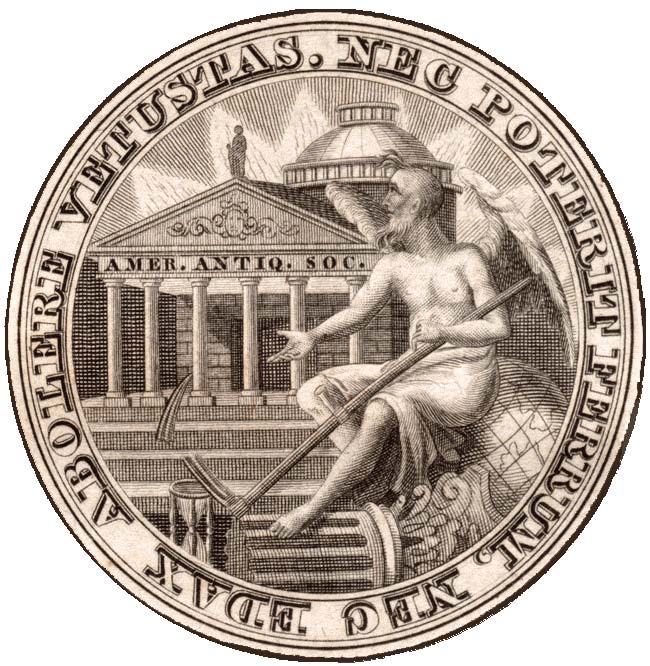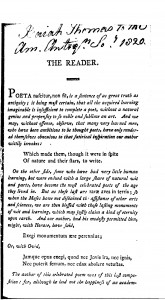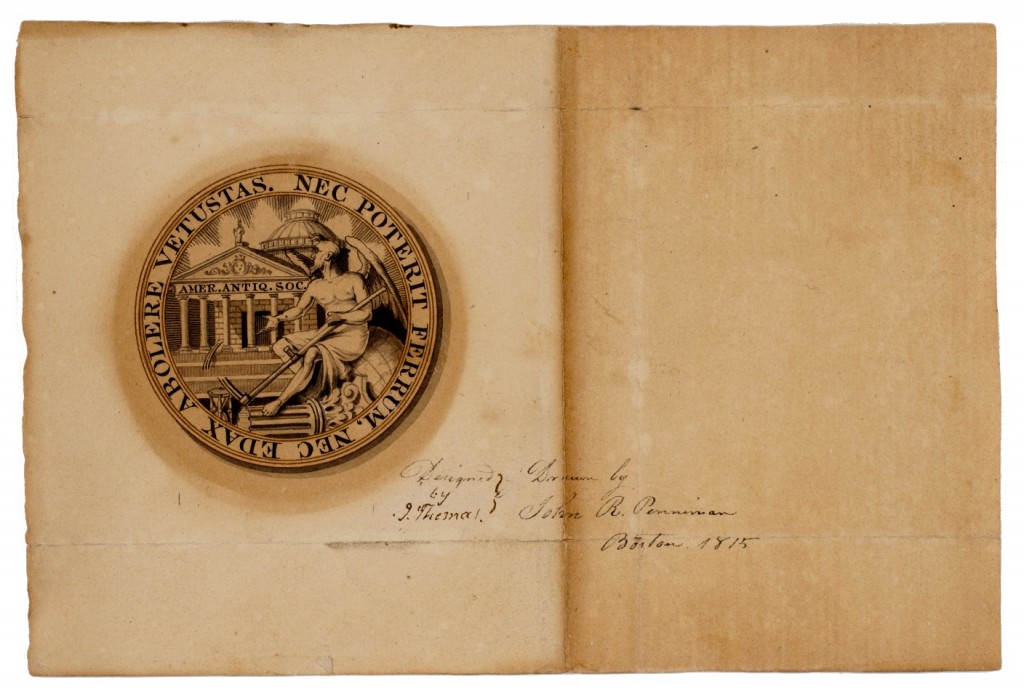The Society has published two new books in this, its bicentennial year. The works are completely different and from the hands of different authors and designers, both of whom incorporated the Society’s seal on the back cover. With all this extra attention to this device, Abby Hutchinson, who edits the Society’s newsletter, Almanac, concluded that it was significantly historic to include a short piece in her publication. As only the broad contours of the story fit the space available in the AAS Heritage column, the editors of Past is Present welcomed a longer version.
The Society’s seal was formally inaugurated in 1820. That year, in January, the Council, the Society’s governing board, voted to issue membership diplomas “to which the seal of the Society shall be affixed” to qualifying members. Later in the year, the seal was incorporated into the title page engraved by Abner Reed for the first issue of Archaeologia Americana, The Transactions and Collections of the American Antiquarian Society. Like so many other early initiatives of the Society, the seal — along with the charter, the founding collection, and even the first Antiquarian Hall — was the brainchild of Isaiah Thomas. The seal’s very existence sprang from Thomas’s vision and generous spirit. To be sure, he tried to engage other members as committees to make these ideas a reality, but the Society’s early records show that Thomas took the lead at critical moments.
The creation of the official stamp for the seal of the Society turned out to be a complicated affair. The committee appointed to complete the task got cold feet when it learned just how costly it was to sink the die and dragged its feet, rather than commit to that expenditure. The story was pieced together by Waldo Lincoln, then the Council President, at the Society’s centennial in 1912. He assembled the earliest records of the Society from disparate sources predating the regular and consecutive publication of annual meeting records that began in 1849. He also had historical notes compiled by Edmund M. Barton that were published in the Proceedings for October 1897 as part of his librarian’s report prompted by the Council’s vote (October 22, 1895) to consider revising the Society’s seal. The single-volume Proceedings of the American Antiquarian Society, 1812-1849 appeared with lengthy footnotes but without illustrations, leaving room for yet another review in time for the bicentennial.
Barton began his account of his historical exploration by noting that “the original drawing was not only preserved but framed by our founder.” (This accounts for the fold that centered the drawing in the frame even as it obscured part of Thomas’s note about its origin.) Barton then recounted what he had learned of the difficulties encountered in the effort to turn the art into a mechanical device. To the vote taken on October 24, 1814, to accept the “device for the seal of the Society” as reported by the committee for that purpose, was appended the names of members [Nathaniel G.] Snelling and Sam’l J. Prescott to the committee to “get the same engraven on steel for the use of the Society.” Later, when he went looking, Lincoln could not find the 1814 committee report — only one from the following year that was officially described as “progress.”
According to the summary, the 1814 report recorded the acceptance of John R. Penniman’s commission. The following year, perhaps motivated by the expense of transferring it to a die, the committee reported that “they have caused a drawing of the seal” to be made by Mr. Penniman “reduced from his original design.” This is confirmed by the treasurer’s receipted bill of May 22, 1815, in the Society’s archives:
Received of Mr. Isaiah Thomas, Jnr, eight dollars. Being in full for a Design & Drawing a Seal for the Antiquarian Society [signed} John R. Penniman.
The price quoted to the committee for the mechanical seal turned out to be higher than anticipated. The Boston engraver Aaron Merrill Peaslee “informed them that he could not undertake it for less than 50 dollars, if in brass and 100 dollars if in steel, exclusive of a case and screw, which will be a further expense of from 40 to 50 dollars.” No action appears to have been taken on Peaslee’s estimate and the committee was directed “to make further inquiries.”
This was slow going, and in a letter to Thomas (February 9, 1818), Snelling indicated that as the job could not be done in Boston, he suggested that as “in New York and Philadelphia there are many first-rate foreign artists to whom the process of dye-sinking is perfectly familiar,” the Boston-oriented committee should be disbanded. His formal report in April 1818, that “it was impossible to have it executed” recommended that the Society’s corresponding secretary, Samuel Burnside, transmit a copy of the drawing for engraving to a New York member with whom he was acquainted, John G. Bogert, or some other member there to have the seal engraved by the “first artist in the city, on brass, silver, or steel.” The next action was taken in October 1818, when Snelling complied with the vote of the April meeting by sending Thomas the original and duplicate drawings of the seal. Next, Thomas made a diary note on March 27, 1819, indicating that he had written to the Hartford engraver, Abner Reed, “respecting engraving the seal for the Am. Antiq’n So’y and sent him the drawing or devise.” Thomas paid Reed’s bill for $25 in June and the Sub Council noted in December that “a seal for the Society has been handsomely engraved and presented this evening to the Society by the President.” At the same time, Thomas also, at his own expense, had a membership diploma engraved by Reed. With a seal that could be embossed on a paper wafer and affixed to the diploma, the Society had a way to recognize eligible members (those who had paid their annual subscription of $6.00 per Article IX of the “Laws of the American Antiquarian Society).
For the next dozen years, there is no further word on the seal and the diploma. All seemed well, although the earliest group of diplomas in the Society’s collection indicate that the seal made at best a light impression when embossed on the round paper wafer that was affixed to the diploma. The seal made a stronger impression as part of Reed’s elaborate — and signed — engraving for the title page of the first volume of Archaeologia Americana (The Transactions of the American Antiquarian Society) published in 1820.
In 1832, the Council voted to obtain a smaller version of the seal. But when, in 1836, the second volume of the Transactions appeared, it was devoid of the engraved title page and without a seal. Three years later, in 1839, the Council returned to the subject of the seal, voting to have it adapted so that could be used “with common sealing presses.” Not until 1847 was the librarian authorized to “procure paper to be stamped for use.” If this is the coated paper with a light lavender hue that was used for the seal for Samuel Foster Haven’s membership diploma, it is clear that at last the problem of the ‘weak impression’ left by the earlier seal had been resolved.
The motto that appears on the seal, “nec poterit ferrum nec edax abolere vetustas,” is from Ovid’s Metamorphoses (Book 15, l.872), and when combined with line 871, reads “Now I have completed my work, which neither sword nor devouring Time will be able to destroy.” Thomas’s choice of a text seems to speak for itself—or does it? It can be considered a sign of his anticipation of a secure future for the Society, but these lines might also have held special resonance that might not have come from reading Ovid’s narrative poem.
 Thomas’s initial gift of books does not include a copy of Metamorphoses, but he was aware of these lines from their appearance in another volume in his possession. Thomas’s copy of Samuel Butler’s Hudibras (London, 1739; repr. Troy, New York, 1806) opens with a preface declaring that poets are born, not taught. The author then backpedaled in a way that would surely have appealed to Thomas: “some who have had very little human learning, but were endued with a large share of natural wit … have become the most celebrated poets of the age they lived in.” The two lines from Ovid are cited as proof that while “he had not had the happiness of an academical education, as some affirm, it may be perceived, throughout his whole poem, that he had read much and was very well accomplished in the most useful parts of human learning.” Is it surprising that the self-taught Thomas inscribed this page when he gave this volume to the Society in 1820?
Thomas’s initial gift of books does not include a copy of Metamorphoses, but he was aware of these lines from their appearance in another volume in his possession. Thomas’s copy of Samuel Butler’s Hudibras (London, 1739; repr. Troy, New York, 1806) opens with a preface declaring that poets are born, not taught. The author then backpedaled in a way that would surely have appealed to Thomas: “some who have had very little human learning, but were endued with a large share of natural wit … have become the most celebrated poets of the age they lived in.” The two lines from Ovid are cited as proof that while “he had not had the happiness of an academical education, as some affirm, it may be perceived, throughout his whole poem, that he had read much and was very well accomplished in the most useful parts of human learning.” Is it surprising that the self-taught Thomas inscribed this page when he gave this volume to the Society in 1820?
And if after reading this, you would like copies of the seal for your own collection, please indulge us in a little shameless commerce. They may be found on the dust jackets of Joseph J. Felcone’s New Jersey Printing, 1754-1800: A Descriptive Bibliography and Phlip F. Gura’s The American Antiquarian Society, 1812-2012: A Bicentennial History. As with all of the Society’s books, they are available from Oak Knoll Press (http://www.oakknoll.com/).

